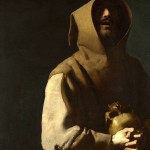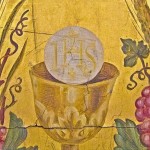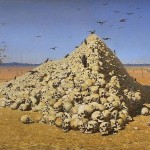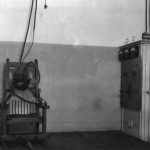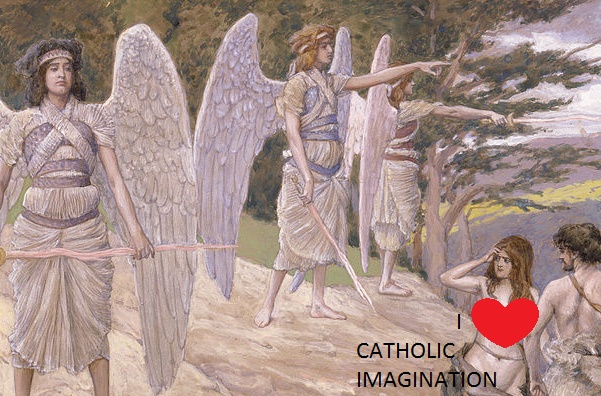
. . . A pure thing, against the sad affairs of earth. Pure, forbidden the use of certain words:
Toilet, telephone, ticket, ass, money . . .~ Czesław Miłosz, A Treatise on Poetry
The Catholic Imagination is a strange and wonderful thing. My fascination with it goes all the way back when I first came to the States to stay in 1986. Before that I might’ve seen a Lutheran church or two, but never participated in a Protestant service. Even at this point I can still count my attendance at such events on my hands, perhaps even only one hand. What always strikes me is how much the emphases of Catholicism are from the more dialectical, frequently world denying, anti-sacramental, Protestant, especially Calvinist, Protestant Imagination. I cannot understand the sparse interiors and lecture-like liturgies. I lack training in them. They do no correspond to the comprehensive view of the world that the Catholic Imagination has inculcated in me. I would have to become a different person in order to fully engage Protestant services and Protestant ways of thinking. Things might be different for American Catholics who have either grown up exposed to Protestantism, or have converted from it. This is how they stand with me.
Such discoveries a major obsession of mine that developed into my doctoral dissertation on the Catholic imagination of the Polish poet Czeslaw Milosz. Michael Martin recently gave me the opportunity to think about the Catholic imagination once more with an essay that appears in the collection, The Heavenly Country: An Anthology of Primary Sources, Poetry, and Critical Essays on Sophiology. I’m still developing my thoughts on this topic and am trying to figure out how to classify the Eastern Orthodox tradition
Here’s a rather large appetizer from The Heavenly Country for you:
The Irish philosopher Richard Kearney differentiates the literary imagination of James Joyce as one where “the scatological and the eschatological rub shoulders.” In turn, James Joyce, in Finnegans Wake imagined that a “truly catholic assemblage” would be one where H.C.E. reigns, that is, “Here Comes Everybody.” How are we to imagine such a boundless Catholicism, capable of embracing the wisdom (sophia) of God’s world like Bernini’s colonnades in St. Peter’s Square? The concept of the imagination is fundamental to revitalizing such a properly Catholic way of hospitably engaging the world beyond superficial liberal and conservative labels that only serve the status quo. The imagination should not be confused with mere fancy; rather, an imagination has its own specific parameters that issue in an intellectual, physical, and material comportment to God, the world, and fellow man. I will provisionally venture the thesis that the concept of the imagination—more specifically the nature of the Catholic imagination—should be one of the foundations for anchoring the emerging discipline of Catholic Studies in a rigorous manner. Answers to the following basic questions will help us orient ourselves: What is an imagination? What are its implications? What is so unique about a Catholic imagination?
The symbolist poet Oskar Milosz provides a preliminary answer to the first question in his Epistle to Storge. Here he speaks of a basic human need for placement within the cosmos: “It could be said of the compulsion to situate all things (including the space and time in which we situate them) that it is the first of our life’s mental manifestations. Certainly there is no thought and emotion which does not derive from this essential activity of being.” The dynamic and intimate tie between the human mind, emotions, and the world—close in its thrust to what phenomenology understands by intentionality—is what we will understand as an imagination. The imagination’s compulsion to situate all things does not come in one variety. Every intellectual-spiritual-material formation marks its members in its own unique ways.
One useful way of conceptualizing how an imagination works was outlined in David Tracy’s now classic The Analogical Imagination. There he describes how an imagination arranges the relationship between three fundamental concepts: God, man, and the world. Tracy characterizes the Catholic assemblage of things as “analogical,” because it stresses the close interplay, the analogies, between God, man, and the world. This issues in a stress upon the immanence of the divine within (frequently painful and suffering-filled) human affairs and the cosmos. That is the eschatological in the scatological, if you will. Czesław Miłosz describes the thrust of the analogical imagination in a more poetic idiom in his Visions from San Francisco Bay:
All humanity, past and present, is, in truth, a Church persisting outside ordinary space and time, a Church opposed to the necessity built into the universe. Catholicism is the most anthropocentric of religions and, in some sense, through its own excess of divine humanity, it resists the exact sciences which annihilate the individual. Thus, paradoxically, it is less susceptible than other religions to the disintegrative influence of science and technology. In Catholicism, even Heaven and Earth, the Descent and the Ascension of God are not like relations between worlds but like those between human forms [and their suffering, tragic dimension].
Yet, the eminence of science and technology, even in our late modern world, is undeniable. It is undeniable even when Bultmann’s Lutheran project of demythologizing the scriptures in the wake of mid-century scientific progress seems hopelessly out of date, “The world-view of the Scripture is mythological and is therefore unacceptable to modern man whose thinking has been shaped by science and is therefore no longer mythological.” In a late modern context, with a global ecological disaster looming, we are much more inclined, like Pope Francis in Laudato Si’, to demythologize science and its frequently less than salutary intentions and effects.
Czesław Miłosz is also an invaluable guide here. Here is how he describes the corrosive effects on the Catholic imagination of divorcing mind from matter, spirit from the body in Road-side Dog:
Instead of leaving to theologians their worries, I have constantly meditated on religion [in my poetry]. Why? Simply because someone had to do this… I lived in a time when a huge change in the contents of the human imagination was occurring. In my lifetime Heaven and Hell disappeared, the belief in life after death was considerably weakened [and so on]… After two thousand years in which a huge edifice of creeds and dogmas has been erected, from Origen and Saint Augustine to Thomas Aquinas and Cardinal Newman, when every work of the human mind and of human hands was created within a system of reference, the age of homelessness has dawned. How could I not think of this?
Michael Martin points out in his The Submerged Reality this state of affairs goes back much further than the Scientific Revolution. It is the end-result of a post-nominalist sundering of nature from grace. It is impossible to avoid thinking about this, because that great divorce structures our possible ways of imagining and inhabiting the world. In some ways, the Protestant imagination—followed by the scientific, literary-critical, neoliberal and other modern imaginations—institutionalized these tendencies through a dialectical emphasis of God’s transcendence over and against man and the world.
What does it mean to speak of the dialectical emphasis of the Protestant imagination? Tracy’s tripartite schema is useful here as well. The dialectical imagination places God over, above, and against humanity and the world. God’s transcendence of creation is accentuated so as to almost form a complete break. The metaphors the Calvinist theologian Karl Barth uses in The Epistle to the Romans are a paradigmatic 20th century example of what we mean when we speak of a Protestant dialectical imagination:
The effulgence, or, rather, the crater made at the percussion point of an exploding shell, the void by which the point on the line of intersection makes itself known in the concrete world of history, is not—even though it be named the Life of Jesus—that other world which touches our world in Him. In so far as our world is touched in Jesus by the other world, it ceases to be capable of direct observation as history, time, or thing.
Here not even the ascents or descents of the God-man form relations between this world and the other world, which only touches us with a void rather than a human presence. In Oskar Milosz’s (and later Czesław’s) terms this imagination of reality makes God homeless in the world. To be fair to Barth, later in his career he does say in The Humanity of God that the position he occupied in The Epistle to the Romans could not and “was not the last word.” It would only be fair to say that not all forms of Protestantism gravitate toward his earlier extremely dialectical position; some, like high Anglo-Catholicism, are not infrequently more analogical than most mainstream forms of Roman Catholicism. But it is also true that, if we go back to Czesław Miłosz’s analysis of the breakdown of the Catholic edifice, a drift away from an analogical imagination toward a dialectical imagination is the source of the contemporary crisis of the Catholic imagination and its theologies…
If this has piqued your interest, you can read the rest in The Heavenly Country: An Anthology of Primary Sources, Poetry, and Critical Essays on Sophiology.
You might also want to read the following from this blog: Ruined by Books: TOP10 Catholic Studies Books
Stay in touch! Like Cosmos the in Lost on Facebook:
Please consider making a donation to this blog through the donation button on the upper right side of its homepage.

